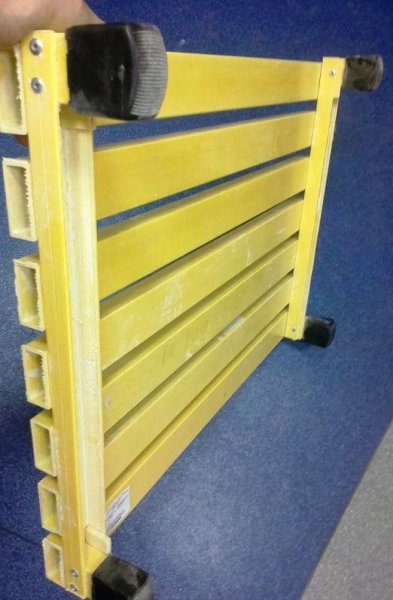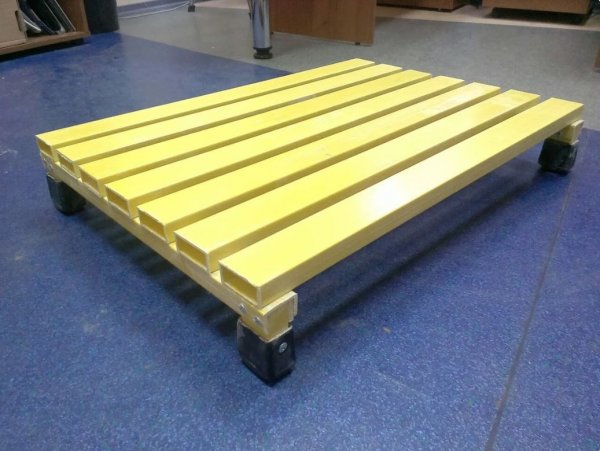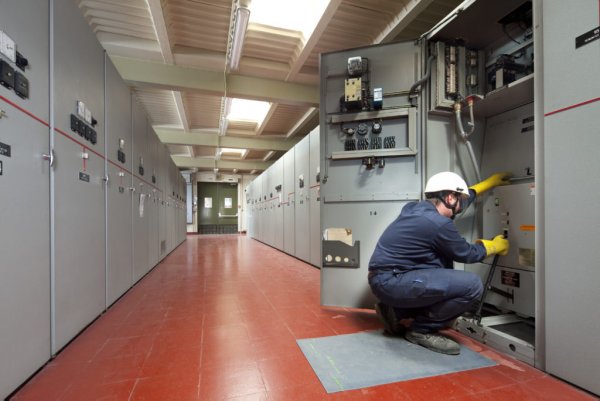Insulating pads and dielectric rubber mats
Isolation stands
Insulating stands are widely used for various live work in installations with a nominal voltage up to and above 1000 V. Stands, if they meet the known requirements, can serve as the main protective device, i.e. a worker standing on a stand is considered sufficiently isolated from the ground.
For voltages above 10,000 V, insulating supports are of less importance, since at such voltages only special live work is allowed, carried out with the help of special tools - rods and pliers. When using these tools, insulating supports are unnecessary only if the tools meet all the safety rules established for them.
Isolation supports consist of a floor that rests on the legs, that is, they look like large benches (footrests). The best material for flooring is wood, which should be well dried and painted with oil paint. In addition, the wood must be straight-grained and free of knots.In particular, wood for stands intended for outdoor devices must be well treated so that the material is completely moisture resistant.
A hard and smooth plank floor cannot be allowed, because on such a floor workers slip and fall easily, which is a great danger in the immediate vicinity of live parts. Therefore, the surface of the flooring must be rough, which can be achieved using wooden planks or planks supported on thicker wooden frames.
The boards must be stacked frequently, with gaps of no more than 2.5 cm, otherwise the heel can get stuck in the gap between adjacent boards.
Recently, fiberglass insulation supports have become widespread.
The main insulating part is the legs of the stand, which must therefore be made of porcelain or other equivalent insulating material.
In addition, it is necessary to have sufficient leg height, in particular, to allow moisture or spilled water on the floor. The minimum height of the legs from the floor to the lower surface of the deck is set at 5 cm for voltages up to 1000 and 8 cm for voltages above 1000 V.
The stability of the isolation stand must be fully ensured, even when a person is at the very edge of the stand. Therefore, the outer edges of the flooring must not extend beyond the edges of the supporting surfaces of the legs. Overhangs and protrusions on the deck can cause the supports to overturn and should therefore be avoided.
In order to easily and comfortably perform the necessary work while standing on the isolation stand, the stand must have sufficient area.Otherwise, the worker will feel insecure on the stand and will be limited in his movements, which is especially undesirable when working under pressure.
On the other hand, too large sizes of insulating supports are undesirable, since in this case the movement of the stand, its cleaning, inspection, etc. is very difficult.
The minimum size of the insulation pads is 50 x 50 cm.[
All insulating pads should be periodically surge tested. Look - Testing of protective equipment
In addition to the electrical test, all insulation supports must also undergo a mechanical strength test. This test shall consist of the racks being loaded with a certain weight which the racks shall be able to withstand without any harm to themselves.
Particular attention should be paid to keeping the insulation pads clean and tidy. In this respect, floor stands are at a particular disadvantage compared to other protective means and devices.
Covering the stand with a layer of conductive dust and dirt may negate its insulating properties, in which case the stand may do more harm than good because the worker, considering himself sufficiently protected by the stand, will not take other precautions. [banner_adsense]
A thorough cleaning of the stalls should be carried out regularly, at least once every 3 months, together with an external inspection. When the stand is in a dusty and dirty room, cleaning should be done much more often. Insulation pads must be installed in such a way that they are not difficult to inspect and clean.
From this point of view, it should be recognized as undesirable to continuously cover the floor of the room with racks located next to each other. With such an arrangement, access to the lower surface of the flooring and to the legs of the uprights is very difficult, or dust and dirt easily accumulate under the uprights, which are difficult to remove from there. The purpose of the isolation support is to protect the worker while doing a specific job in a specific location.
Dielectric rubber mats
Rubber pads or mats play the same role as insulating pads. In any case, carpets cannot replace the stands, as the latter are much inferior to the stands in terms of the reliability of the insulating effect.
In fact, no matter how carefully they are made, carpets, like other rubber products, are prone to punctures, cuts and other damage that can negate the insulation properties of the carpet. In addition, used in dirty and damp rooms, with a relatively small thickness, they can easily be covered with a conductive layer and wet, after which the restoration of their insulating properties can be difficult.
Finally, rubber is subjected to action, light, temperature, excessive dryness, etc., as a result of which its mechanical and electrical properties can change significantly. For these reasons, mats, like other rubber protectors, can only serve as a primary means of protection at low voltage. At high voltages (above 1000 V), pads are allowed as an additional protection measure, that is, in addition to pads, other protective means must be used.
To eliminate the possibility of slipping, the surface of the rubber pad must be rough, which is easily achieved by using rubber with a grooved, corrugated or lattice surface.
The minimum dimensions of dielectric insulation mats are 50 x 50 cm.

In addition to testing, the carpets must undergo an external inspection at least once a month, and in case of healing, bubbles, small holes, third, protrusions, foreign inclusions and other defects, the carpets must be withdrawn from circulation. The storage of carpets, like other rubber protective equipment, should be carried out in a closed, dark, not too dry room at a temperature of 15 ° to 25 ° C.
In addition to the isolation of the feet from the floor, rubber mats or mats can be used in the production of electrical work to close adjacent live parts, as well as to close earthed objects that are close to those live parts on which works. The use of carpets for this purpose can be particularly advisable, since no insulating support can serve as protection in the event of simultaneous accidental contact with a live and grounded part or two live parts.



